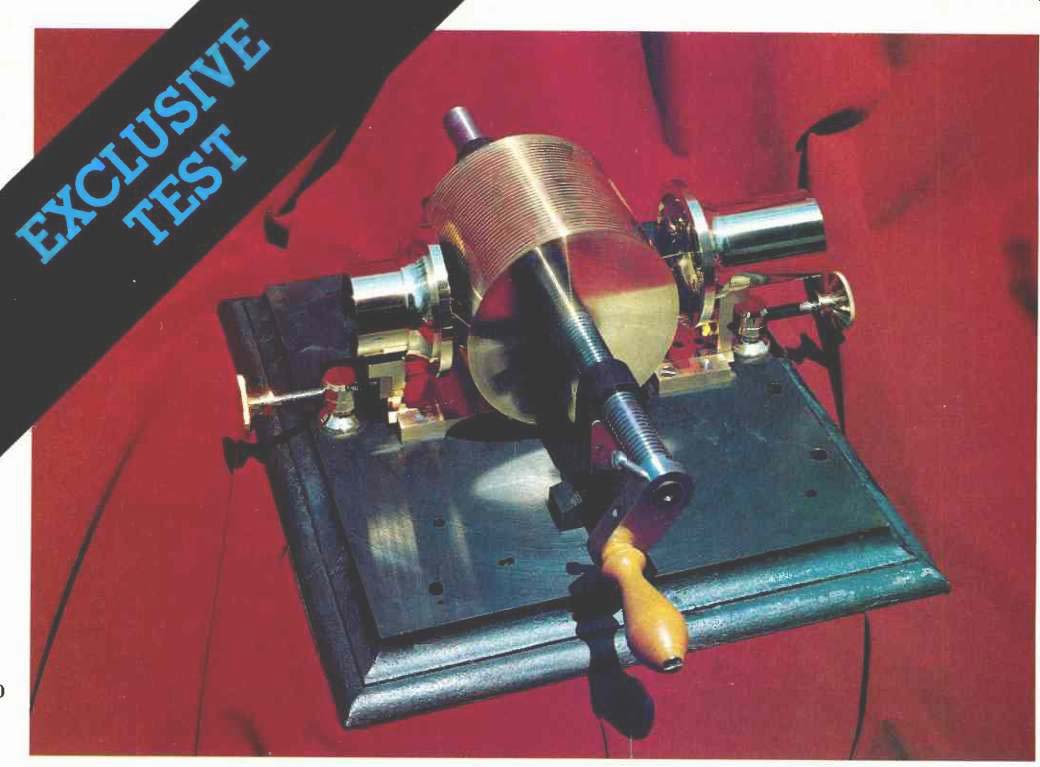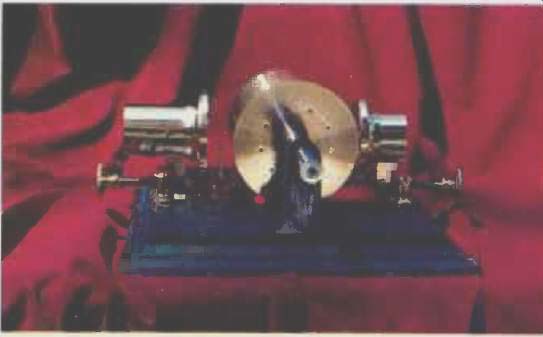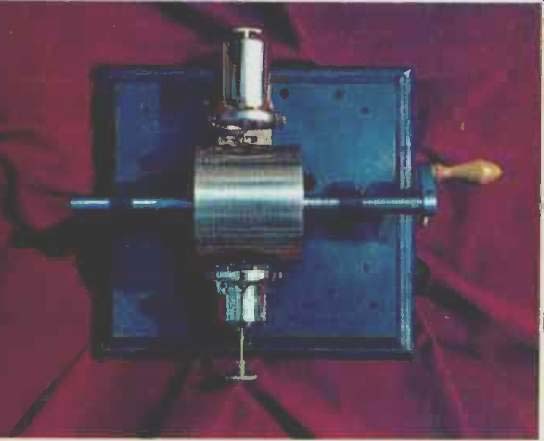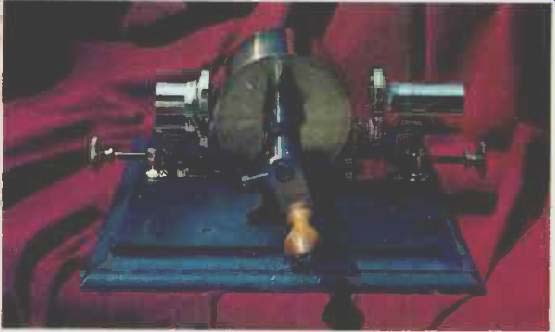
MANUFACTURER'S SPECIFICATIONS
Speeds: Continuously variable by user, a fixed speed of 60 rpm is recommended.
Recording and Playback Time: 32 sec. at 60 rpm.
Motor: Arm muscles.
Drive Method: Direct.
Cylinder: 4.97 in (10.1 cm) diameter.
Flutter: Improves with practice.
Tracking Error: None, tangential.
Tracking Force: Adjust with enough force to follow undulations in the tin foil without obliterating them.
Recording Medium: 2 mil tin-clad-lead foil (28 per cent tin by weight).
Groove Density: 10 per inch (3.9 per cm). [2]
Recording Method: Vertical (hill and dale) with constant groove velocity.
Recording Stylus: Steel, 16 mil radius, conical.
Playback Stylus: Steel, 16 mil radius, conical.
Acoustical Output: Audible to an audience provided considerable force is used when speaking directly into mouthpiece; chest tones are best.
Acoustical Performance: Voice can be recorded and reproduced instantly with fidelity and distinctness, as can whistles, laughter, songs, and sound effects, including musical sounds.
Dimensions: 14.3 in. (36.4 cm) W with cylinder centered by 10.6 in. (27 cm) D by 5.2 in. (13.2 cm) H with handle down.
Weight:15.3 lbs. (6.95 kg).
Price: Variable; must be built from a set of plans available from Edison Laboratories at Menlo Park, N.J. [2] Materials include bronze, brass, steel, malleable iron. At least 100 hours of a professional machinist's time are required.



[sorry …missing content from orig. article] ... and posterity, it would be better to write them down. I have heard that Edison is working on an improved version for production. If this is true, I recommend you wait for the up dated model.
By Dr. Peter E. Hillman PhD. Research Associate, Dept. of Agricultural Engineering, Cornell University, Ithaca, New York 14853.
Manufacturer's Comment:
We are working on an improved production model of the Edison Tin-Foil Phonograph which should be available by Spring, '78. A single diaphragm is excellent for both recording and playback, and our new phonograph incorporates a single mica diaphragm for both purposes. You must realize that we were anxious to demonstrate the phonograph and to file application with the patent office as soon as possible, without taking time for improvements, [20] hence the marked change between this version and our original phonograph.
In addition to a single diaphragm, our new phonograph has a host of improvements.' A flywheel has been added to reduce flutter. The mouth-piece diaphragm assembly swings down for greater clearance than on the original phonograph-hence facilitating ease of wrapping the foil around the cylinder. Also a slot has been added to the cylinder in which to fit the ends of the foil and a wedge holds the ends in place. Lateral screw adjustments of the diaphragm assembly are provided. The stylus is no longer rigidly fastened to the mica diaphragm. Instead, a piece of rubber tubing is placed between the stylus and the mica diaphragm, reducing the metallic noise. Stylus shape has been changed to improve volume and clarity. The mica diaphragm is variably damped, reducing the resonant peaks and raising the frequency response by adding stiffness. Slots have been added to the mouthpiece to reinforce sibilant sounds. Finally, we provide a funnel to greatly increase the volume of playback.
We believe the phonograph does have utility, especially our improved model. We predict that it can be used for letter writing, dictation, books for the blind, education, music, recording the last words of great men, and as music boxes, toys, clocks ... just to name a few uses.
- The Edison Speaking Phonograph Co.
References and Notes
1. Johnson, E. H. ( Edison Speaking Phonograph Co.) Instructions for Management and Operation of Edison's Speaking Phonograph. Philadelphia, 1878.
2. Edison Laboratories' drawings of original phonograph, 1930. Copies entitled, Build the Edison Tin-Foil Phonograph, are available at $2.25 each from Eastern National Park and Monument Association, Edison National Historic Site, P.O. Box 126, Orange, N.J. 07051.
3. The type of foil used on the original phonograph was surmised from the oldest documented tin foil sample (#14281) at the Edison National Historic Site. This sample had been used on the first phonograph exhibited in Nashville, Tenn. on June 18, 1878. The relative content of tin and lead was calculated from a density measurement of this sample. Apparently this sample is a sandwich of tin with a lead center. A note from Mining World, July 6, 1906; reads, "Tin-foil is supposed to contain more tin than other metal, but this is not so. The Crookes method of manufacturing tin-foil is by rolling plates of lead coated with tin." I am still trying to find out when tin foil was first manufactured by the Crookes method.
4. Stylus shape is not clearly depicted in the drawings of the phonograph (reference 2). Visual examination of the original at the Edison National Historic Site revealed the recording and playback styli are conical.
5. Advertising handbill for an exhibition of Edison's phonograph in July, 1878.
6. U.S. Patent No. 200,521 granted February 19, 1878.
7. Scientific American, "The Talking Phonograph." 37:384, 1877.
8. Josephson, M. Edison: A Biography, New York, McGraw Hill, Inc. 1959.
9. I am greatly indebted to the Edison National Historic Site and its staff for allowing me to examine archival material crucial to this study. Not only is the original phonograph displayed there, but also models of his other famous inventions, his books, and his tools. It is well worth a visit. I am also indebted to Sam Baughman for advice and supervision while constructing the phonograph replica for this review.
10. Read, O. and W. J. Welch. From Tin Foil to Stereo, Indianapolis, Howard W. Sam & Co., Inc., (2nd ed.)1976.
11. Young, J. L., Edison and His Phonograph. 1890. Reprinted by Talking Machine Review, Bournemouth, England.
Mouth glue is either a gelatin glue or saliva (Oxford English Dictionary, 1933). I found that transparent tape placed at the edges of the overlapping foil works nicely.
12. Samples of tin-clad-lead foil (40 percent tin by weight) and pure tin foil were obtained courtesy of Revere Cop per and Brass, Inc., Foil Division, Brooklyn, N.Y. 11222.
13. I used a commercial heavy-duty aluminum foil.
Aluminum probably was not sold as a foil in 1877 because tin foil worked as well for wrapping and wasn't nearly as expensive. Until Halls' electrolysis method for reducing aluminum in 1888, aluminum rivaled gold in price.
14. Lyman, T. (ed.) Metals Handbook. Vol. 1. Properties and Selection of Metals. Novelty, Ohio. American Society of Metals, (8th ed.) 1961.
15. A Nicolet Scientific Corp. Ubiquitous Spectrum Analyzer Model UA500A was used for this test. I thank Dr. Cornelis Drost for his aid in measuring the frequency response and signal-to-noise ratios.
16. The frequency response of the phonograph is reminiscent of a steel diaphragm earphone (Olson, H. F. Modern Sound Reproduction. New York, Van Nostrand Reinhold Co., 1972, p. 58.).
17. Kinsler, L. E. and A. R. Frey. Fundamentals of Acoustics. New York, John Wiley & Sons, Inc. (2nd ed.)1962.
18. A notch filter was used to determine the percent contribution of the distortion to the fundamental.
19. This section is strictly my imagination of how Edison might reply to my equipment review. I assume sole responsibility for its content.
20. Elisha Gray just missed the valuable telephone patent by arriving two hours later than Alexander Bell at the U.S. Patent Office on February 14, 1876 (reference 8).
21. Edison, T. A., "The Phonograph and Its Future." North American Review. 126: 527-536.1878.
-----------
(adapted from Audio magazine, Dec. 1977)
Also see:
Wags and Tales That Started A Revolution (Dec. 1977)
Phonograph Reproduction --1978: part 1 (May 1978)
Phonograph Reproduction --1978: part 2 (Jun. 1978)
Recordings for Critical Listening (Jan. 1978)
= = = =